You want to write killer copy.
Copy that captivates, compels, and more importantly, converts.
But copywriting isn’t as easy as it looks.
You need the right blend of copywriting skills to capture your reader’s attention, connect with their emotions and convince them to click.
So what are these coveted copywriting skills, and how can you use them to create irresistible copy?
That’s exactly what this post will cover.
I’ll explain the 10 most crucial copywriting skills for writing captivating copy, along with some clever and creative examples from real copywriters, so you can see the skills in action.
Ready to whip your copywriting chops into shape?
Let’s get started.
1. Hit ‘Em With a Hook
Human attention spans are incredibly short.
You may only have a second – maybe even a millisecond, to get readers interested in what you have to say.
So you need to use that millisecond wisely by making your first sentence into an irresistibly interesting hook.
Hooks are designed to grab readers’ attention and get them invested in reading more.
Good hooks are:
- Short and snappy
- Relevant to the reader
- Curiosity provoking
If you want to see brilliant hooks in action, just look at viral X/Twitter “threads”.
Check out this post (tweet) from copy editor Erica Schneider:
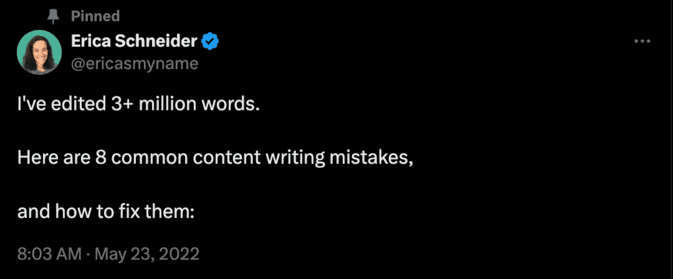
The first line, “I’ve edited 3+ million words” is only 4 words long, but it’s intriguing because of the sheer number of words she’s edited.
It makes you want to click on the thread and learn more from her, because she has so much experience.
But you don’t have to have a ton of experience to write a good hook. You just have to understand your audience and their pain points.
Take a look at financial coach Ramit Sethi’s hook for his social skills training program, How to Talk to Anybody:

“I was tired of feeling awkward” is a short but powerful sentence that will immediately resonate with anyone who has ever felt socially awkward.
Within that millisecond, the reader thinks “Oh yeah, that’s me…” and will automatically read on.
2. Write Magnetic Headlines
Want to know another way to snap your audience to attention?
Write a killer headline.
Headlines are the main title of a landing page, blog post or podcast episode, and they’re likely the first thing your reader will see.
They’ll have to click on the headline to see your content, so if you can’t get them to click, you’ll lose them – probably for good.
The best way to make your headlines magnetic is to offer a specific, irresistible benefit that’s relevant to your target audience.
Let’s look at a headline from entrepreneur Eban Pagan’s sales page:

The benefit here is “double your productivity” – but he also adds a little something extra: a desirable time frame (90 days).
How many times have you seen headlines like: “Double Your Income in 6 Months” or “Lose Weight and Increase Your Energy in 30 days”?
They’re effective because everyone wants to accomplish their goal quickly.
Now let’s look at a blog headline:

This blog headline from Shopify offers two benefits: “go viral” and “drive sales” – both are enticing benefits for their audience of ecommerce business owners.
Lastly, we’ll look at a podcast headline:
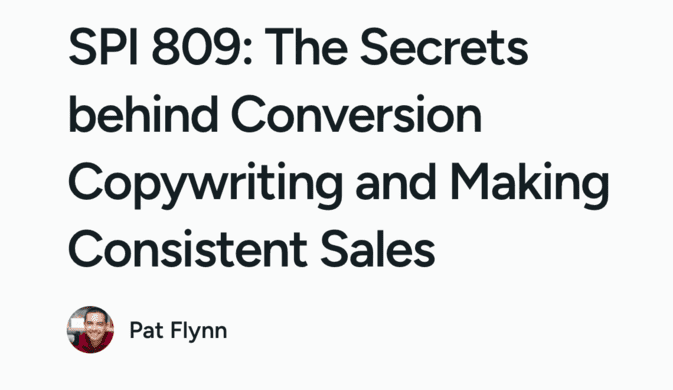
The benefits here are: “conversion copywriting secrets” and “making consistent sales”.
And using the word “secrets” makes the headline even more intriguing, because it makes you feel like he’s letting you in on insider info.
3. Tell a Relatable Story
Good copywriting makes an instant connection with the reader.
It makes you nod your head and say, yeah, I’ve been there (or I am there).
And there’s no better way to connect with your reader than to tell them a story they can relate to.
Let’s take a look at how entrepreneur Marie Forleo uses storytelling on her site, where she sells her business course, B School:
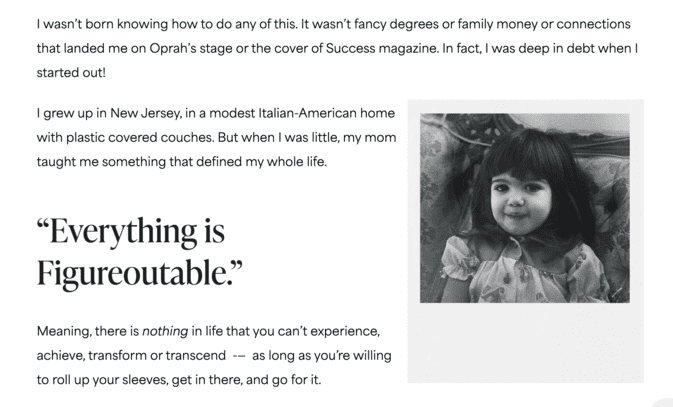
“I wasn’t born knowing how to do any of this” is a great hook, and it instantly brings Marie down to the level of her audience.
Talking about how she was in debt and living on “plastic-covered couches” creates vivid imagery of working-class upbringing – a common experience for her target readers.
As a bonus, this story indirectly addresses the possible reader objection: “But I’m not some fancy-pants person with a degree and connections!”
She wasn’t either, and look at her now.
4. Keep it Short
Good copywriting is never wordy.
Remember those short attention spans? You’ve got to keep them in mind with every single word you write.
So you need to say what you have to say in as few words as possible.
For example, check out entrepreneur Seth Godin’s description of his book and course, “This is Strategy”:
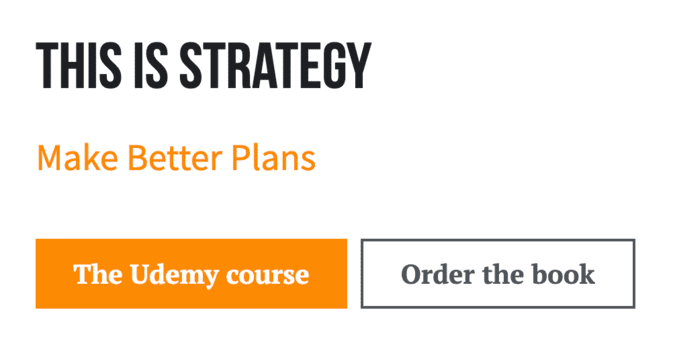
He very effectively describes the benefits to the book and course in three words: “make better plans”.
Another company known for succinct copy is Apple:
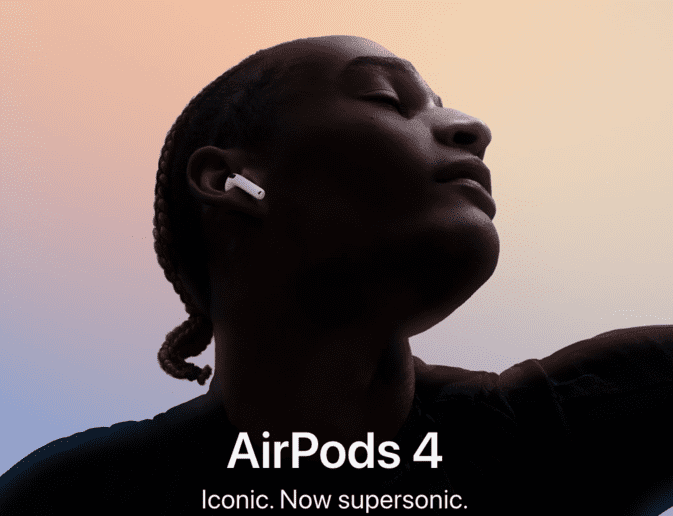

In these ads, Apple uses only 2 words to describe each product – then the user can click through to read the full product description and features.
5. Be Persuasive
The whole point of copywriting is to get your reader to take action.
You want them to buy the product, join the email list or listen to the podcast.
So your writing must be persuasive.
Every copywriting skill on this list will help you write more persuasively. But here are some additional tips:
- Address your readers’ pain points and desires
- Create a sense of urgency
- Build trust through offering value
Here’s an example from a sales page from the company Copyhackers, selling their copywriting course:
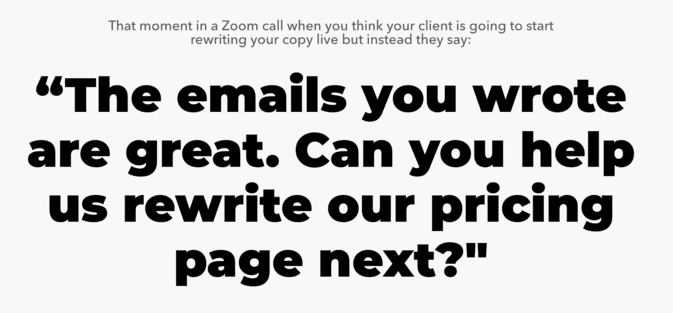
This copy captures a very common pain point for copywriters: having to rewrite their work when the client isn’t happy.
Copyhackers wants you to envision that process going differently after you’ve taken their course, and it uses an imaginary quote from a happy client to do it.
Now let’s look at some persuasive email writing from Jon Morrow:

He starts with a bold statement that lends him credibility: “I’ve made 15 million dollars writing emails”.
Then he offers to let you see those exact emails that made him the money, and assures you that you could adapt them to make your own profit.
You have absolutely nothing to lose and everything to gain by clicking the link.
And giving his email collection away for free also builds trust with the reader.
6. Simplify Complexity
The product you’re writing about may be complex, but your copy doesn’t have to be.
Your copy should use simple language so your audience can understand the benefits they’ll get from the product or service, without having to understand every little detail of how it works.
You can simplify complexity by:
- Avoiding technical jargon
- Using conversational language
- Keeping copy short and simple
This copy explaining Tesla’s solar panels is a perfect example:

This description uses simple language to explain why someone would choose to install solar panels in their home, without using any technical jargon.
Marketing expert Neil Patel also simplifies complexity in his sales copy for his digital marketing tools:

Neil offers an array of tools that help analyze complex marketing data. But he sums it all up in these two lines.
7. Elicit Emotion
The world’s most brilliant copywriters know how to tap into emotion.
They put our deepest desires, fears and frustrations into words – sometimes more effectively than we can!
The best way to use emotion in your copywriting is to empathize with your target reader and the problems that keep them up at night.
Look at this headline copy from Rami Sethi’s course about following through with your commitments:
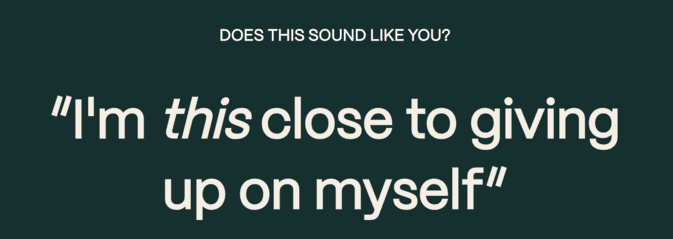
This is an emotionally charged statement that would resonate deeply with anyone who has trouble finishing what they start.
Or how about this copy from therapist and author K.C. Davis for her course about tidying up your home when you’re depressed:

Here, she acknowledges how difficult it is to clean when you’re suffering from depression, and reassures the reader that a perfectly clean house isn’t nearly as important as they think.
8. Anticipate Objections
Most readers don’t really want to spend money.
So when they read your copy, they’re coming up with internal reasons why they shouldn’t buy what you’re selling.
You can get ahead of this process by addressing their objections head-on.
You can do it indirectly through your writing, like in this copy from a sales page for the Copywriting Inkubator course:

This copy effectively addresses the potential objection: “I have no experience”.
You can also address objections directly through a Frequently Asked Questions (FAQ) section, like this one from the same sales page:
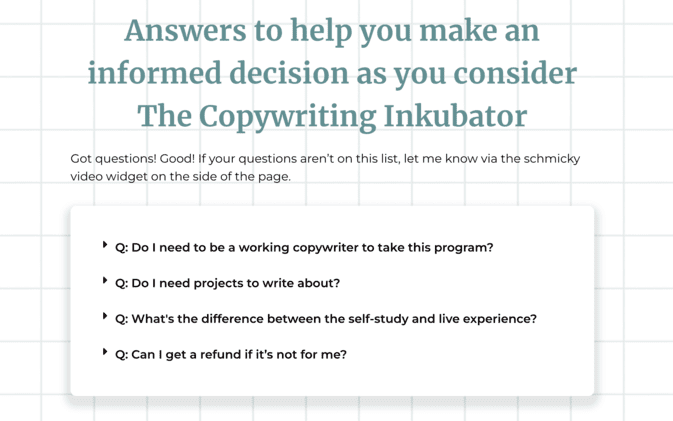
This FAQ section addresses several objections all in one place, and stating her intention to help the reader “make an informed decision” is a major trust-builder.
9. Show Social Proof
Sometimes, the most compelling copy isn’t even written by you.
It’s written by people who have tried the product and achieved positive results.
How many times have you bought a product on Amazon without scrolling down to see all the product reviews? Never, right?
Product reviews and customer testimonials are the two most common types of social proof, and you can leverage them to make your copy incredibly persuasive.
Look at how course creator Amy Porterfield uses customer testimonials to show social proof:
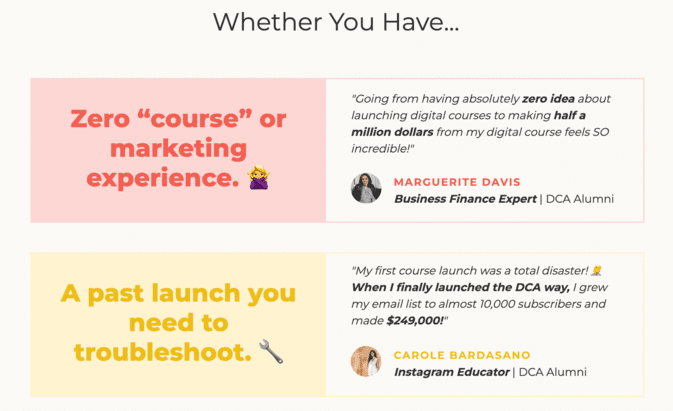
Here, Amy leverages the customer testimonials as social proof while also addressing potential objections.
10. Call Them to Action
Your copy has one last chance to get your reader to click: your call to action (CTA).
This is the last few lines of copy the reader sees before they make the decision to take action or exit out of your site.
Good CTAs use action-oriented language to give the reader one final, persuasive nudge.
This CTA from Crazy Egg uses a short, action-based phrase to elicit a psychological response: fear.
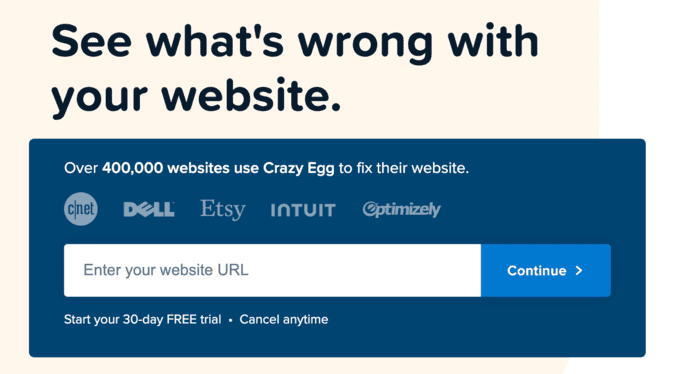
Every website owner worries about bugs in their site that slow it down or make it less effective.
Crazy Egg makes it super simple to relieve this worry by asking for their email address in return for a free site analysis.
Let’s look at one more effective CTA, from Marie Forleo:

Here, she creates urgency in the reader by saying enrollment for the course is time-limited, and uses action-based language with “click the button to enroll now!”.
Use Your Copywriting Skills to Create Killer Copy
Now you know the essential copywriting skills to supercharge your copy.
But skills only improve with practice!
So go out there and start grabbing readers’ attention with irresistible hooks and headlines.
Connect with their emotions and captivate them through storytelling.
Keep it simple, keep it concise, and make it compelling.
Your audience will respond with confident clicks.
The post 10 Killer Copywriting Skills For Irresistible Copy (+ Examples) appeared first on Smart Blogger.

No comments:
Post a Comment